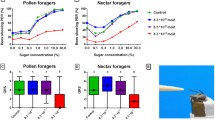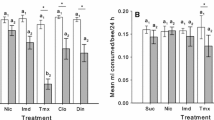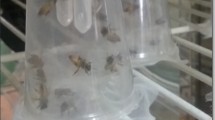Abstract
Honeybees and other pollinators are threatened by changing landscapes and pesticides resulting from intensified agriculture. In 2018 the European Union prohibited the outdoor use of three neonicotinoid insecticides due to concerns about pollinators. A new pesticide by the name of “Sivanto” was recently released by Bayer AG. Its active ingredient flupyradifurone binds to the nicotinic acetylcholine receptor (AchR) in the honeybee brain, similar to neonicotinoids. Nevertheless, flupyradifurone is assumed to be harmless for honeybees and can even be applied on flowering crops. So far, only little has been known about sublethal effects of flupyradifurone on honeybees. Intact motor functions are decisive for numerous behaviors including foraging and dancing. We therefore selected a motor assay to investigate in how far sublethal doses of this pesticide affect behavior in young summer and long-lived winter honeybees. Our results demonstrate that flupyradifurone (830 µmol/l) can evoke motor disabilities and disturb normal motor behavior after a single oral administration (1.2 µg/bee). These effects are stronger in long-lived winter bees than in young summer bees. After offering an equal amount of pesticide (1.0–1.75 µg) continuously over 24 h with food the observed effects are slighter. For comparisons we repeated our experiments with the neonicotinoid imidacloprid. Intriguingly, the alterations in behavior induced by this pesticide (4 ng/bee) were different and longer-lasting compared to flupyradifurone, even though both substances bind to nicotinic acetylcholine receptors.




Similar content being viewed by others
Data availability
All necessary data are available in the online supplementary information or under the following link: https://figshare.com/s/818f15bb365a925670dc.
References
Aizen MA, Harder LD (2009) The global stock of domesticated honey bees is growing slower than agricultural demand for pollination. Curr Biol 19:915–918. https://doi.org/10.1016/j.cub.2009.03.071
Alkassab AT, Kirchner WH (2018) Assessment of acute sublethal effects of clothianidin on motor function of honeybee workers using video-tracking analysis. Ecotoxicol Environ Saf 147:200–205. https://doi.org/10.1016/j.ecoenv.2017.08.047
Beck ME, Gutbrod O, Matthiesen S (2015) Insight into the binding mode of agonists of the nicotinic acetylcholine receptor from calculated electron densities. Chemphyschem 16:2760–2767. https://doi.org/10.1002/cphc.201500341
Beketov MA, Liess M (2008) Acute and delayed effects of the neonicotinoid insecticide thiacloprid on seven freshwater arthropods. Environ Toxicol Chem 27:461–470. https://doi.org/10.1897/07-322R.1
Bicker G (1999) Histochemistry of classical neurotransmitters in antennal lobes and mushroom bodies of the honeybee. Microsc Res Tech 45:174–183. https://doi.org/10.1002/(SICI)1097-0029(19990501)45:3<174:AID-JEMT5>3.3.CO;2-L
Breer H, Sattelle DB (1987) Molecular properties and functions of insect acetylcholine receptors. J Insect Physiol 33:771–790. https://doi.org/10.1016/0022-1910(87)90025-4
Butler CG (1945) The influence of various physical and biological factors of the environment on honeybee activity. An examination of the relationship between activity and nectar concentration and abundance. J Experiment Biol 21:5–12
Campbell JW, Cabrera AR, Stanley-Stahr C, Ellis JD (2016) An Evaluation of the Honey Bee (Hymenoptera: Apidae) safety profile of a new systemic insecticide, flupyradifurone, under field conditions in Florida. J Econ Entomol 109:1967–1972. https://doi.org/10.1093/jee/tow186
Coulom H, Birman S (2004) Chronic exposure to rotenone models sporadic Parkinson’s disease in Drosophila melanogaster. J Neurosci 24:10993–10998. https://doi.org/10.1523/JNEUROSCI.2993-04.2004
Cresswell JE, Robert F-XL, Florance H, Smirnoff N (2014) Clearance of ingested neonicotinoid pesticide (imidacloprid) in honey bees (Apis mellifera) and bumblebees (Bombus terrestris). Pest Manag Sci 70:332–337. https://doi.org/10.1002/ps.3569
Danner N, Keller A, Härtel S, Steffan-Dewenter I (2017) Honey bee foraging ecology: season but not landscape diversity shapes the amount and diversity of collected pollen. PLoS ONE 12:e0183716. https://doi.org/10.1371/journal.pone.0183716
Delaplane KS, Mayer DF (2000) Crop pollination by bees. CABI, Wallingford
Desneux N, Decourtye A, Delpuech J-M (2007) The sublethal effects of pesticides on beneficial arthropods. Annu Rev Entomol 52:81–106. https://doi.org/10.1146/annurev.ento.52.110405.091440
EFSA (2015) Conclusion on the peer review of the pesticide risk assessment of the active substance flupyradifurone. EFS2 13:4020. https://doi.org/10.2903/j.efsa.2015.4020
Eiri DM, Nieh JC (2016) A nicotinic acetylcholine receptor agonist affects honey bee sucrose responsiveness and decreases waggle dancing. J Exp Biol 219:2081. https://doi.org/10.1242/jeb.143727
European Commission (2018a) Commission ImplementingRegulation (EU) 2018/783 of 29 May 2018 amending Implementing Regulation (EU) No 540/2011 as regards the conditions of approval of the active substance imidacloprid. Off J Eur Union 132:31–34. Accessed 21 Aug 2018
European Commission (2018b) Commission ImplementingRegulation (EU) 2018/784 of 29 May 2018 amending Implementing Regulation (EU) No 540/2011 as regards the conditions of approval of the active substance clothianidin:L 132/35-39. Accessed 21 Aug 2018
European Commission (2018c) Commission ImplementingRegulation (EU) 2018/785 of 29 May 2018 amending Implementing Regulation (EU) No 540/2011 as regards the conditions of approval of the active substance thiamethoxam. Off J Eur Union 132:40–44. Accessed 21 Aug 2018
European Food Safety Authority (2012) Statement on the findings in recent studies investigating sub‐lethal effects in bees of some neonicotinoids in consideration of the uses currently authorised in Europe. EFS2 10:440. https://doi.org/10.2903/j.efsa.2012.2752
Friard O, Gamba M, Fitzjohn R (2016) BORIS: A free, versatile open-source event-logging software for video/audio coding and live observations. Methods Ecol Evol 7:1325–1330. https://doi.org/10.1111/2041-210X.12584
Gauglitz S, Pflüger H-J (2001) Cholinergic transmission via central synapses in the locust nervous system. J Comp Physiol A: Sens, Neural, Behav Physiol 187:825–836. https://doi.org/10.1007/s00359-001-0253-y
Glaberman S, White K (2014) Environmental fate and ecological risk assessment for foliar, soil drench, and seed treatment uses of the new insecticide flupyradifurone (BYI02960). U.S. Environmental Protection Agency Office of Pesticide Programs, Environmental Fate and Effects Division EFED, Environmental Risk Branch IV 187
Goulson D, Nicholls E, Botías C, Rotheray EL (2015) Bee declines driven by combined stress from parasites, pesticides, and lack of flowers. Science 347:1255957. https://doi.org/10.1126/science.1255957
Hallmann CA, Sorg M, Jongejans E, Siepel H, Hofland N, Schwan H, Stenmans W, Müller A, Sumser H, Hörren T, Goulson D, Kroon Hde (2017) More than 75 percent decline over 27 years in total flying insect biomass in protected areas. PLoS ONE 12:e0185809. https://doi.org/10.1371/journal.pone.0185809
Henry M, Béguin M, Requier F, Rollin O, Odoux J-F, Aupinel P, Aptel J, Tchamitchian S, Decourtye A (2012) A common pesticide decreases foraging success and survival in honey bees. Science 336:348–350. https://doi.org/10.1126/science.1215039
Hesselbach H, Scheiner R (2018) Effects of the novel pesticide flupyradifurone (Sivanto) on honeybee taste and cognition. Sci Rep 8:4954. https://doi.org/10.1038/s41598-018-23200-0
James RR, Xu J (2012) Mechanisms by which pesticides affect insect immunity. J Invertebr Pathol 109:175–182. https://doi.org/10.1016/j.jip.2011.12.005
Jeschke P, Nauen R, Gutbrod O, Beck ME, Matthiesen S, Haas M, Velten R (2015) Flupyradifurone (Sivanto™) and its novel butenolide pharmacophore: Structural considerations. Pestic Biochem Physiol 121:31–38. https://doi.org/10.1016/j.pestbp.2014.10.011
Klatt BK, Holzschuh A, Westphal C, Clough Y, Smit I, Pawelzik E, Tscharntke T (2014) Bee pollination improves crop quality, shelf life and commercial value. Proc Biol Sci 281:20132440. https://doi.org/10.1098/rspb.2013.2440
Klein A-M, Vaissière BE, Cane JH, Steffan-Dewenter I, Cunningham SA, Kremen C, Tscharntke T (2007) Importance of pollinators in changing landscapes for world crops. Proc Biol Sci 274:303–313. https://doi.org/10.1098/rspb.2006.3721
Knopper LD, Dan T, Reisig DD, Johnson JD, Bowers LM (2016) Sugar concentration in nectar: a quantitative metric of crop attractiveness for refined pollinator risk assessments. Pest Manag Sci 72:1807–1812. https://doi.org/10.1002/ps.4321
Krupke CH, Hunt GJ, Eitzer BD, Andino G, Given K (2012) Multiple routes of pesticide exposure for honey bees living near agricultural fields. PLoS ONE 7:e29268. https://doi.org/10.1371/journal.pone.0029268
Lambin M, Armengaud C, Raymond S, Gauthier M (2001) Imidacloprid‐induced facilitation of the proboscis extension reflex habituation in the honeybee. Arch Insect Biochem Physiol 48:129–134. https://doi.org/10.1002/arch.1065.abs
Lee D, O’Dowd DK (1999) Fast excitatory synaptic transmission mediated by nicotinic acetylcholine receptors in Drosophila neurons. J Neurosci 19:5311–5321. https://doi.org/10.1523/JNEUROSCI.19-13-05311.1999
Mitchell EAD, Mulhauser B, Mulot M, Mutabazi A, Glauser G, Aebi A (2017) A worldwide survey of neonicotinoids in honey. Science 358:109–111. https://doi.org/10.1126/science.aan3684
Mullin CA, Frazier M, Frazier JL, Ashcraft S, Simonds R, Vanengelsdorp D, Pettis JS (2010) High levels of miticides and agrochemicals in North American apiaries: implications for honey bee health. PLoS ONE 5:e9754. https://doi.org/10.1371/journal.pone.0009754
Nation JL (2008) Insect physiology and biochemistry, 2nd edn. CRC Press, Hoboken
Nauen R, Ebbinghaus-Kintscher U, Schmuck R (2001) Toxicity and nicotinic acetylcholine receptor interaction of imidacloprid and its metabolites in Apis mellifera (Hymenoptera: Apidae). Pest Manag Sci 57:577–586. https://doi.org/10.1002/ps.331
Nauen R, Jeschke P, Velten R, Beck ME, Ebbinghaus-Kintscher U, Thielert W, Wolfel K, Haas M, Kunz K, Raupach G (2015) Flupyradifurone: a brief profile of a new butenolide insecticide. Pest Manag Sci 71:850–862. https://doi.org/10.1002/ps.3932
Potts SG, Biesmeijer JC, Kremen C, Neumann P, Schweiger O, Kunin WE (2010) Global pollinator declines: trends, impacts and drivers. Trends Ecol Evol 25:345–353. https://doi.org/10.1016/j.tree.2010.01.007
Pyakurel P, Shin M, Venton BJ (2018) Nicotinic acetylcholine receptor (nAChR) mediated dopamine release in larval Drosophila melanogaster. Neurochem Int 114:33–41. https://doi.org/10.1016/j.neuint.2017.12.012
Rinkevich FD, Margotta JW, Pittman JM, Danka RG, Tarver MR, Ottea JA, Healy KB (2015) Genetics, synergists, and age affect insecticide sensitivity of the honey bee, Apis mellifera. PLoS ONE 10:e0139841. https://doi.org/10.1371/journal.pone.0139841
Rondeau G, Sánchez-Bayo F, Tennekes HA, Decourtye A, Ramírez-Romero R, Desneux N (2014) Delayed and time-cumulative toxicity of imidacloprid in bees, ants and termites. Sci Rep 4:5566. https://doi.org/10.1038/srep05566
Rortais A, Arnold G, Halm M-P, Touffet-Briens F (2005) Modes of honeybees exposure to systemic insecticides: Estimated amounts of contaminated pollen and nectar consumed by different categories of bees. Apidologie 36:71–83. https://doi.org/10.1051/apido:2004071
Sanchez-Bayo F, Goka K (2014) Pesticide residues and bees–a risk assessment. PLoS ONE 9:e94482. https://doi.org/10.1371/journal.pone.0094482
Sánchez-Bayo F, Belzunces L, Bonmatin J-M (2017) Lethal and sublethal effects, and incomplete clearance of ingested imidacloprid in honey bees (Apis mellifera). Ecotoxicology 26:1199–1206. https://doi.org/10.1007/s10646-017-1845-9
Schneider CW, Tautz J, Grünewald B, Fuchs S (2012) RFID tracking of sublethal effects of two neonicotinoid insecticides on the foraging behavior of Apis mellifera. PLoS ONE 7:e30023. https://doi.org/10.1371/journal.pone.0030023
Schröter U, Malun D, Menzel R (2007) Innervation pattern of suboesophageal ventral unpaired median neurones in the honeybee brain. Cell Tissue Res 327:647–667. https://doi.org/10.1007/s00441-006-0197-1
Smirle MJ (1993) The influence of colony population and brood rearing intensity on the activity of detoxifying enzymes in worker honey bees. Physiol Entomol 18:420–424. https://doi.org/10.1111/j.1365-3032.1993.tb00616.x
Suchail S, Guez D, Belzunces LP (2001) Discrepancy between acute and chronic toxicity induces by imidacloprid and its metabolites in Apis mellifera. Environ Toxicol Chem 20:2482. https://doi.org/10.1897/1551-5028(2001)020<2482:DBAACT>2.0.CO;2
Tan K, Wang C, Dong S, Li X, Nieh JC (2017) The pesticide flupyradifurone impairs olfactory learning in Asian honey bees (Apis cerana) exposed as larvae or as adults. Sci Rep 7:17772. https://doi.org/10.1038/s41598-017-18060-z
Tennekes HA (2010) The significance of the Druckrey-Küpfmüller equation for risk assessment–the toxicity of neonicotinoid insecticides to arthropods is reinforced by exposure time. Toxicology 276:1–4. https://doi.org/10.1016/j.tox.2010.07.005
Tison L, Hahn M-L, Holtz S, Rößner A, Greggers U, Bischoff G, Menzel R (2016) Honey Bees’ behavior is impaired by chronic exposure to the neonicotinoid thiacloprid in the field. Environ Sci Technol 50:7218–7227. https://doi.org/10.1021/acs.est.6b02658
Tosi S, Nieh JC (2017) A common neonicotinoid pesticide, thiamethoxam, alters honey bee activity, motor functions, and movement to light. Sci Rep 7:15132. https://doi.org/10.1038/s41598-017-15308-6
Tosi S, Costa C, Vesco U, Quaglia G, Guido G (2018) A 3-year survey of Italian honey bee-collected pollen reveals widespread contamination by agricultural pesticides. Sci Total Environ 615:208–218. https://doi.org/10.1016/j.scitotenv.2017.09.226
Whitworth AJ, Wes PD, Pallanck LJ (2006) Drosophila models pioneer a new approach to drug discovery for Parkinson’s disease. Drug Discov Today 11:119–126. https://doi.org/10.1016/S1359-6446(05)03693-7
Williamson SM, Willis SJ, Wright GA (2014) Exposure to neonicotinoids influences the motor function of adult worker honeybees. Ecotoxicology 23:1409–1418. https://doi.org/10.1007/s10646-014-1283-x
Winston ML (1987) Biology of the honey bee, New edn. Harvard University Press, Cambridge
Acknowledgements
We thank our departmental beekeeper Dirk Ahrens for beekeeping. We thank Laura Degirmenci for help with the manuscript.
Funding
We thank the Heinrich Stockmeyer Stiftung, Bad Rothenfelde, for financial support to HH.
Author contributions
HH gained data. Both authors wrote the main manuscript text and HH prepared all of the figures. Both authors reviewed the manuscript.
Author information
Authors and Affiliations
Corresponding author
Ethics declarations
Conflict of interest
The authors declare that they have no conflict of interest.
Additional information
Publisher’s note: Springer Nature remains neutral with regard to jurisdictional claims in published maps and institutional affiliations.
Supplementary Information
Rights and permissions
About this article
Cite this article
Hesselbach, H., Scheiner, R. The novel pesticide flupyradifurone (Sivanto) affects honeybee motor abilities. Ecotoxicology 28, 354–366 (2019). https://doi.org/10.1007/s10646-019-02028-y
Accepted:
Published:
Issue Date:
DOI: https://doi.org/10.1007/s10646-019-02028-y




